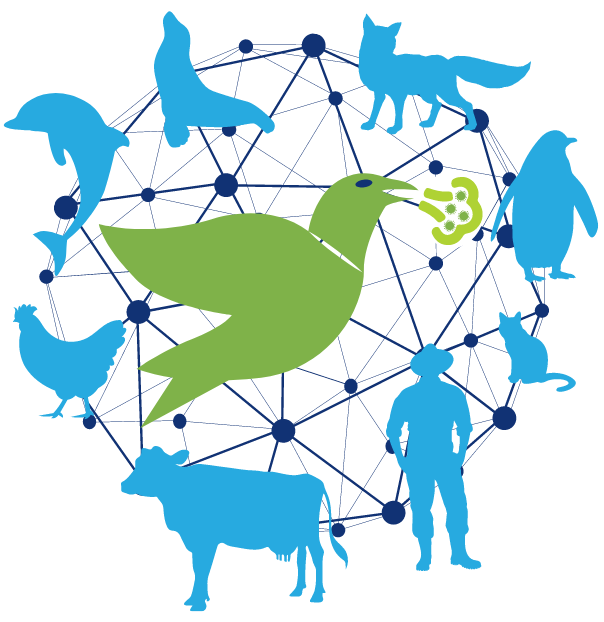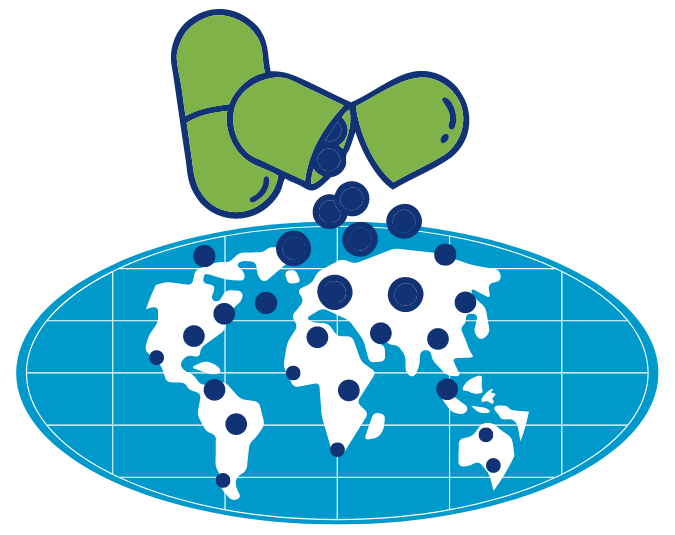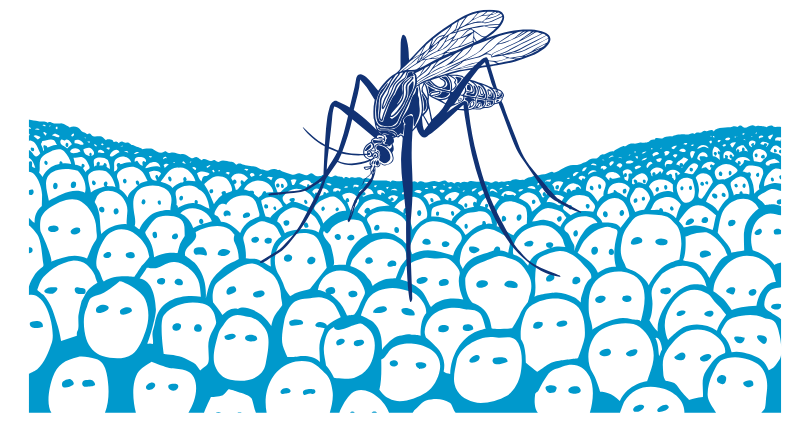
Vaccines save lives. There’s no doubt about this: childhood vaccination saves four million lives every year, the US Centers for Disease Control and Prevention says. Children worldwide get a long list of vaccines, but what about adults?
A report by the Office of Health Economics (OHE), an independent research organization, took a look at the cost-effectiveness of four commonly given adult vaccines: the influenza vaccine, pneumococcal vaccines that protect against a batch of respiratory infections, the herpes zoster vaccine that protects against shingles, and the RSV vaccine that prevents respiratory syncytial virus.
To get a good idea of the value across different types of economies and cultures, they looked at 10 countries: Australia, Brazil, France, Germany, Italy, Japan, Poland, South Africa, Thailand, and the United States. On average, the report found, these 4 adult vaccines gave a 19-fold return, meaning that the benefits equaled 19 times the costs of vaccination. On average, it worked out to US$4,637 per person vaccinated.
Some of the savings are direct – people didn’t rack up hospital costs or miss work if they were vaccinated and evaded serious illness. Some savings were indirect. For instance, “receiving the influenza vaccine reduces the risk of having a stroke and subsequent hospitalization in older adults by 16 percent,” the report reads. “Cancer patients vaccinated with the influenza vaccine also had statistically significantly better survival outcomes, including longer progression-free survival rates and overall survival compared to unvaccinated patients.”
One study cited in the report found that Italian adults vaccinated against flu were 13 percent less likely to die of any cause – not just flu, but any cause – over the 2018-2019 winter flu season than unvaccinated adults.
In this episode of One World, One Health, Dr. Lotte Steuten, Deputy CEO of OHE and co-author of the report, chats about how her team came up with their findings.
Maggie Fox 00:00
Hello and welcome to One World, One Health where we take a look at some of the biggest problems facing our world. I’m Maggie Fox. This podcast is brought to you by the One Health Trust with bite-sized insights into ways to help address challenges, such as infectious diseases, climate change, and pollution. We take a One Health approach that recognizes that everything on this planet — the animals, plants and people, and the climate and environment — are all linked.
There’s little doubt that vaccines save lives, but at what cost? Vaccine campaigns are expensive and complicated for governments and the vaccines themselves cost money of course. The Office of Health Economics and independent health economics research organization set out to put a number on it. They analyze the value delivered by four adult vaccines in ten of the countries they’re available. It’s a surprising amount they found just four commonly given vaccines against influenza pneumococcal disease, respiratory syncytial virus or RSV, and herpes zoster or shingles provide more than $4,600 in benefits for every person vaccinated, it works out to 19 times as much benefit as they cost to deliver. In this episode, we’re chatting with Lotte Steuten, Deputy CEO of the Office of Health Economics, who helped put together the report, we’re going to talk about all the ways the vaccines not only save lives but make people healthier and more productive. Lotte, thanks so much for joining us.
Lotte Steuten 01:38
Thank you. Happy to be here.
Maggie Fox 01:41
You have helped write a report that shows that vaccines pay off literally, can you tell us some of the ways in which they pay off? They save lives. But what else do they do?
Lotte Steuten 01:54
Yeah, so basically the report that we did, so we looked at the return on investment from adults’ vaccination, and indeed we focused first of all, like, you know do they save lives? of course, because that is clearly very important to people. But we also found like other ways in how they pay off, and that is by also by preventing serious disease for example, not getting an infectious disease at all, or if you get it that the consequences are less severe. And then a second way is that the payoff is to the healthcare system. If you don’t get a disease, or, for example, you’re less ill, you may need fewer doctor and hospital visits, hopefully. And that way those resources can be used to help patients. Thirdly, they pay off to society, because they contribute to a very healthy and active workforce throughout the life of our populations. And that can help boost productivity.
Maggie Fox 02:40
And those are almost direct benefits. What are some of the indirect benefits?
Lotte Steuten 02:45
Yes, so that’s a very good question. Productivity is sometimes also considered like an indirect benefit, depending on how policymakers Look at that. But even beyond that, we actually see that these programs can also contribute to health and economic equity within countries and for example, they particularly benefit some of the more vulnerable populations and some of the underserved communities.
That way that’s very important indirect benefit. And on top of that, they can also help to combat antimicrobial resistance. And they can do so by sort of presenting people that develop diseases that would sort of further down the line and potentially need an antibiotic to be treated. So, if you don’t get pneumococcal disease, for example, then you would not need antibiotics. If we reduce the use of antibiotics, that helps with antimicrobial resistance. So that’s another indirect benefit.
Maggie Fox 03:32
And by antimicrobial resistance, we mean the development of these drug resistant germs that don’t respond to antibiotics or antiviral drugs.
Lotte Steuten 03:42
Yes, exactly.
Maggie Fox 03:43
Now people, of course, care about saving lives. But governments also have to think about money and costs. And as you just said, it saves money. But in this report, you put a very precise number on how much money is saved. 19 times return. How do you figure that number out?
Lotte Steuten 04:00
Let me start by telling you a little bit about what is involved in that number. And that helps me to explain how we arrived at this magical number 19. Indeed. So basically, when we did the analysis, we looked, first of all, what are the costs of delivering these adults vaccination programs. So, including the cost of the vaccines, making sure people get their jabs, considering that people need to take off time potentially, to get the jab. And sometimes people have side effects or side effects that need some treatment. So that’s one part of it. So that’s the cost side of the equation. And then we looked at the benefits. And these basically capture sort of three main outcome buckets or benefit buckets. And one is the value that societies place on reducing mortality risk. So, saving lives to fill in the deputy pace on reducing morbidity, so fewer illnesses or less severe illnesses. The third bucket is to impact the positive impact on people’s productivity. So, then how we got to this number 19, we looked at the cost of these programs. We add all those up and then we look at the benefits that we don’t, and the ratio of these two that ends up with number 19. It sounds like a very precise number. And it is. But it’s also the average across all the programs that we studied, and all the countries that are involved in this analysis. So therefore, this is one number that basically represents all of that. So basically, the important thing of understanding the number 19 is, of course, that it will be a little bit different if you look at a specific country and a specific program, but very consistently, across all the results, we found it is always above one and typically well above one and 19, basically, like I said, the sort of best estimate that we have based on the best data available and the methods that are typically used for these types of analysis.
Maggie Fox 05:38
You mentioned that you did this across countries, can you tell us about the ten countries you chose and why?
Lotte Steuten 05:43
We included ten countries in this analysis. And basically, we try to find a set of countries that are quite different in terms of where they are in this world. So, we have countries across the full globe, but also countries that have different income levels, different demographics, different healthcare systems, as well. And we did that to try and establish that across this broad variety of countries and we did see that the value of adult vaccination is consistently positive.
The reason for doing that really is to help policymakers around the world to hopefully see the results for their specific country if they’re part of the ten. But otherwise see country that is a little bit like their country. And that will help them hopefully to understand what the cost benefit of these programs will be in a country like theirs and help them to make decisions. But also, to see that across a very broad diversity of contexts, the results are always positive.
Maggie Fox 06:35
And you might not have these figures to hand but if you do, can you tell us a little bit about where it saved the most money and where it saved the least money?
Lotte Steuten 06:45
That is a very good question. The full report has all the numbers, and I don’t know them specifically from the top of my head. So, I don’t want to call out specific numbers here for that reason. But I think the very important thing is sort of looking at the differences, like when we make decisions, it gets the question for policymakers not so much should we invest in program A or in Program B, because all these diseases happen, and they are very important for people who incur them. They are important to prevent. So, in the same way, yes, we do not decide we will only treat breast cancer, but not prostate cancer, it’s not so much a matter of comparing between these programs, it’s basically really important to understand that they all provide very good value for money. And of course, there are differences and effects sort of. Underlying that are very diverse, it has to do with sort of the incidence of the disease in these different countries, the current healthcare systems that they have the uptake of the vaccines, of course, the price of the vaccines, but also the costs of the healthcare system more generally. So it’s a multitude of factors that really influence higher versus lower costs, cost benefit ratios.
Maggie Fox 07:45
You have another number that you put on all this. And again, it’s an average, I think across all the countries, but it was $4,600 per person in benefits. Can you explain that number to us?
Lotte Steuten 07:56
Yes, I can. So basically, when we calculated all the benefits, cost ratios for all these countries and all these programs, and then we basically estimated like what this would amount to in totality that amounts to billions of dollars to all these people on all these countries or society. And such a big number is really hard to get your head around, really. So, what we did is we took that big number, and then we divided it by the number of full vaccination courses. What I mean by that for flu, for example, you get one shot that you have for vaccination course. And for some of the herpes zoster vaccinations, you need two shots, so might as well be one or two, we basically considered the flu vaccination course. So, we divided that big number by the number of four vaccination courses in depth get you to the number of 4600 per person.
Maggie Fox 08:38
You didn’t look at every single vaccine there is out there for adults, why did you choose the ones that you did choose?
Lotte Steuten 08:45
We looked at the vaccines for flu, pneumococcal disease, respiratory syncytial virus (RSV) and herpes zoster (shingles) and similar to how we made the decision to choose those ten countries, we again looked for different types of programs. So basically, we wanted to have a good balance between more established programs such as flu that has been around for a long time, but also RSV, which is much more of an emerging vaccination program in some countries, and also the programs that we looked at these four they are different than how they impact on our health. Herpes Zoster for example achieves its main benefit to people from improving their quality of life by affording a very painful disease or some of the other programs also save lives which is unlikely in the case of herpes zoster. So very different types of impact. And we felt this was an important mixed sort of go for because we wanted to establish that across this broad variety of vaccination programs that they deliver a positive impact, especially when looking at some of these broader value elements such as productivity, impact on care, quality of life, etc. So yeah, that’s the reason behind the choice for these programs.
Maggie Fox 09:47
Yeah, herpes zoster–shingles. That’s when you really don’t want to get even though it doesn’t kill you. I mean, it’s not a joke to say sometimes you wish you were dead. It’s very painful and debilitating.
Lotte Steuten 09:58
Definitely. Is yeah.
Maggie Fox 10:01
It’s easy to have vaccines for children. Vaccine programs, a lot of it’s tied up with education, but it’s a lot harder to corral adults. Did you have any guidance? Or do you have any guidance for governments on putting together adult vaccination programs?
Lotte Steuten 10:14
Yeah, that is a very good question. I think most people indeed are used to the pediatric of Children’s Act vaccination programs, whereas the adult ones, particularly some of the more novel ones, need a bit more awareness of like, why are these so important for people to go for. I think for governments, it’s really important to understand the benefits that they bring not only to the individual that’s vaccinated, and of course, not having those diseases, but also symptoms of productivity or the workforce, etc. I think that is really important message and making sure that, you know, people are aware of that, and maybe even hep in to sort of make sure there’s this good information out there about the value of those vaccines, but also risks associated with them potential side effects thing, it’s really important that people are well informed about vaccines that they can get.
Maggie Fox 11:00
It might make some people suspicious that this report was commissioned by the International Federation of Pharmaceutical Manufacturers and Associations (IFPMA), is this report just as justification for giving a lot of money to Big Pharma?
Lotte Steuten 11:12
That is a very important question to ask. So, at the Office of Health Economics, we do independent and objective research. And so therefore, we can be stunned by these results. And that very thorough analysis across all the literature, both positive studies, as well as the ditch that maybe do not show the best possible results. We took all the literature on all the data available into this study to come up with the answers and the estimates that we have. These studies will also be submitted for publication in academic journals where they will undergo peer review. So, this is all part of the standards process that independent research organizations like ours always followed sort of justify those results. I think that it’s really important to understand that almost everyone who works in a certain area, whether it’s manufacturers or governments, everyone has their own goals that they want to achieve. And it’s really important to have independent research that is trustworthy to sort of help guide decisions about such important topics.
Maggie Fox 12:07
It might help to tell people a little bit about the Office of Health Economics, how long have you been around?
Lotte Steuten 12:13
Yes indeed. We are the oldest independent health economics research organization in the world, we have existed for over 60 years. Like I said, what we do is objective and independent research on the economics of health. And so therefore, we do this research to really help inform decisions policy around the world to make decisions about you know, how to invest in health and healthcare in the most cost-effective way, which you could say like this. Yeah.
Maggie Fox 12:37
Lotte, thank you so much for joining us.
Lotte Steuten 12:39
Thank you so much for having me.
Maggie Fox 12:40
Listeners, if you enjoyed this podcast, please share it. You can learn more about this podcast and other important topics at onehealthtrust.org. Let us know what else you’d like to hear about on owoh@onehealth trust.org. Thanks for joining us.
Guest

Dr. Lotte Steuten is a health economist by training and is primarily interested in health technology assessment and decision analytic modeling of health innovations.
She is Deputy Chief Executive of Officer of the Office of Health Economics and a visiting honorary professor at City University of London. Lotte is also associate editor at Value in Health and she has published more than 100 peer-reviewed papers.
Lotte’s current research interests include applied health economics, health policy, and market access. She specializes in quantitative methods for estimating and comparing the expected health and economic benefits of new interventions across their lifecycle, and novel approaches to efficiently building the evidence for these.
Credits
Hosted and written by Maggie Fox
Special guest: Lotte Steuten
Produced and edited by Samantha Serrano
Music composed and sound edited by Raquel Krügel







